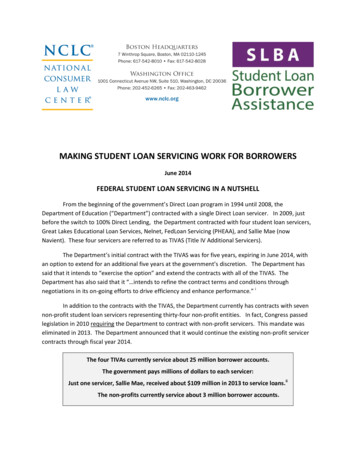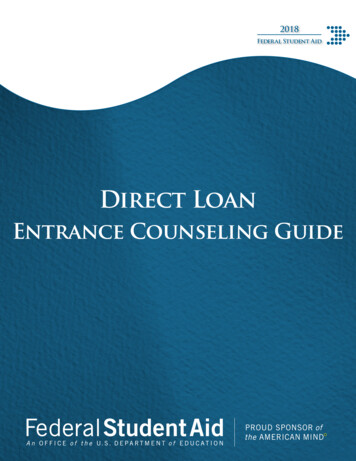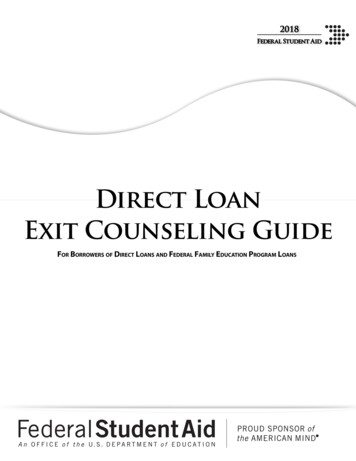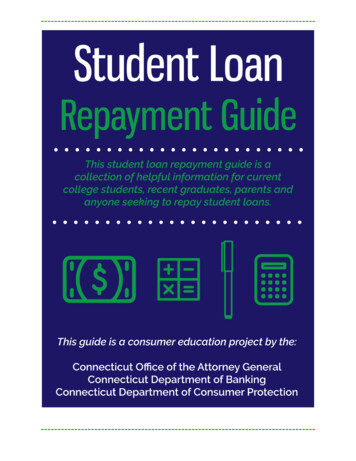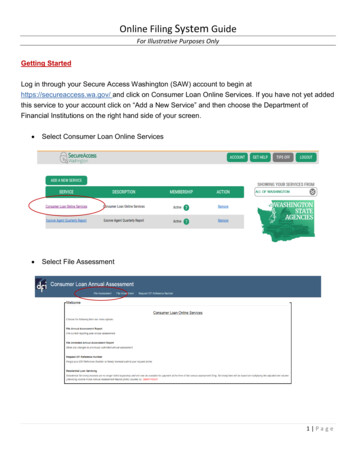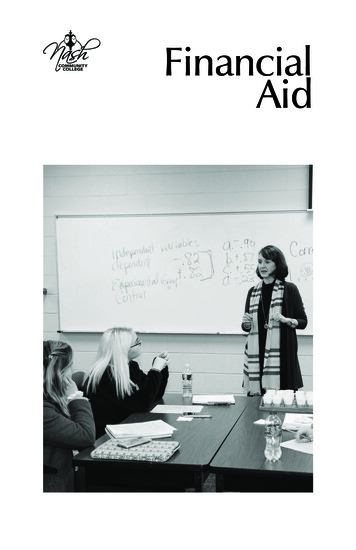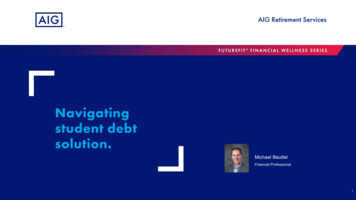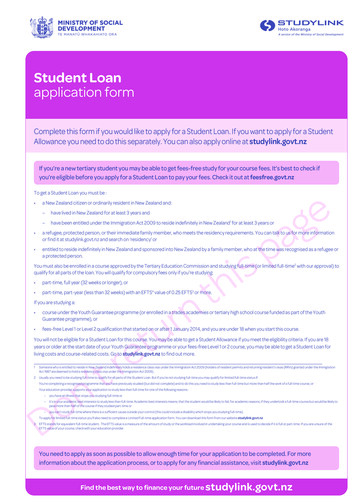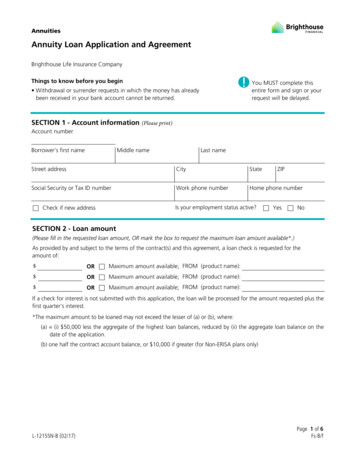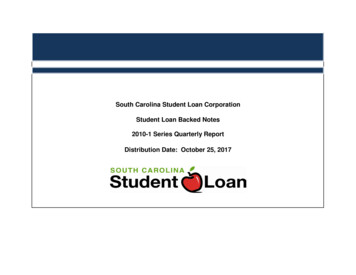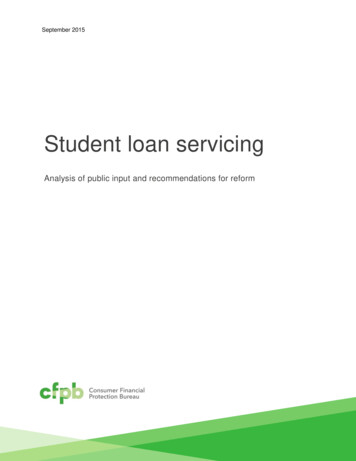
Transcription
September 2015Student loan servicingAnalysis of public input and recommendations for reform
Table of contentsTable of contents. 1Executive summary. 3About this report . 6Introduction . 81. Public input on student loan servicing practices . 161.1Borrower benefits and protections . 171.2Servicing transfers . 451.3Customer service and error resolution . 631.4Payment processing . 711.5Practices impacting specific borrower segments . 892. Public input on analogies to servicing approaches in othermarkets . 1032.1Practices and protections for struggling or delinquent borrowers . 1052.2 Practices and protections related to servicing transfers . 1142.3 Practices and protections related to customer service and errorresolution . 1192.4 Practices and protections related to the processing of payments . 1221
3. Recommendations. 1333.1Consistent . 1363.2 Accurate and actionable. 1383.3 Accountable . 1403.4 Transparent . 142Conclusion . 146Contact information . 147Appendix A: . 148Joint statement of principles on student loan servicing . 1482
Executive summary More than 41 million Americans collectively owe more than 1.2 trillion in student loandebt, making student loan debt the second-largest class of consumer debt behindmortgages. The student loan market continues to show elevated levels of distress relativeto other types of consumer debt, despite recent improvements in the labor market andthe near-universal availability of income-driven repayment plans for borrowers withfederal student loans experiencing financial hardship. The Bureau estimates that morethan 1-in-4 student loan borrowers are now delinquent or in default on a student loan. Significant data gaps exist in the higher education sector, including data related to loanperformance, student outcomes, and certain key demographic, labor, and wage dataabout student loan borrowers. Evidence suggests that some borrowers who default sharecertain characteristics, including attendance at proprietary schools or failure to completea program of study. Improved access to key data is needed, including accesss to datarelated to predictors of future borrower distress, performance of borrowers in alternativerepayment arrangements, and the efficacy of various interventions, and should informpolicymakers and market participants seeking to target resources and reduce defaults. Student loan servicers are a critical link between borrowers and lenders. Servicersmanage borrowers’ accounts, process monthly payments, manage enrollment inalternative repayment plans, and communicate directly with borrowers, includingborrowers in distress. There are no consistent, market-wide federal standards forstudent loan servicing and servicers generally have discretion to determine policiesrelated to many aspects of servicing operations. In May 2015, the Bureau joined with the Department of Education and the Departmentof the Treasury to launch a public inquiry into student loan servicing practices. TheBureau published a notice in the Federal Register requesting comments from the publicon student loan servicing. In response, the Bureau received more than 30,000 comments3
describing specific student loan servicing practices that may be contributing to studentdebt stress, and offering specific recommendations for ways to improve student loanservicing, encourage borrower success, and mitigate defaults. Although not necessarilyrepresentative of the experience of more than 41 million student loan borrowers, publiccomments help to illustrate where there may be a mismatch between borrowers’ needsand actual service delivered. Comments from individual student loan borrowers describe how they encounterservicing problems or practices that discourage utilization of alternative repaymentplans, including income-driven repayment plans. A number of comments describe howsome borrowers may end up in default when they are unable to obtain an alternativerepayment plan. Comments also describe how some servicing practices subsequently canresult in payment shock, lost benefits, and increased interest charges for borrowersenrolled in these plans. Commenters detail problems related to customer service, including issues for borrowersseeking to resolve servicing errors. Commenters describe how these problems createbarriers for borrowers experiencing financial hardship who are seeking to avoid default,and may cause significant credit reporting harm. Commenters describe how payment processing and servicing transfer practices createproblems for borrowers trying to repay student debt. Public comments from individualborrowers describe how these practices cause payment processing problems, increaseinterest charges and late fees, prolong repayment, and create confusion for student loanborrowers. Loan servicers also comment that the complexity of the student loanprograms may contribute to these problems. Commenters, including student loan borrowers, student loan market participants, statelaw enforcement officials and banking regulators, policy experts, and organizationsrepresenting consumers, workers, people of color, and institutions of higher education,call on policymakers to develop student loan servicing standards. Some commentsidentify existing protections for consumers with credit cards or mortgages, suggestingthat these protections may serve as a guide as policymakers and market participantsconsider a framework to improve student loan servicing practices. In addition, the Bureau received comments from servicers, lenders, and organizationsrepresenting the student loan industry. Many of the public and industry commenters4
offer specific recommendations regarding ways to improve student loan servicing,encourage borrower success, and mitigate defaults. Industry commenters, including the two largest participants in the student loan servicingmarket, identify certain student loan servicing practices where there is significantdiversity in the marketplace and suggest that policymakers require consistentapproaches to common servicing functions, while taking into account importantvariations in product terms and features. Other industry commenters suggest alternateapproaches related to specific practices or dispute the need for additional action. In this report, the Bureau suggests a framework to improve student loan servicingpractices, recommending consistent standards for the student loan servicing market,strengthened servicer communications that provide information in a manner that leadsto better borrower outcomes, continued emphasis on accountability and oversight byfederal and state regulators, and public access to robust data on student loanperformance. In September 2015, the Bureau, the Department of Education, and the Department ofthe Treasury issued a Joint Statement of Principles on Student Loan Servicing,proposing a framework similar to the recommendations included in this report.5
About this reportThis report reviews and discusses public comments submitted in response to a Request forInformation Regarding Student Loan Servicing published in the Federal Register in May 2015(Docket ID: CFPB-2015-0021). The notice details a series of topics and questions to elicitfeedback from the public, including: How existing student loan servicing industry practices affect repayment; Whether protections in place in other markets for consumer financial products andservices should be instructive to policymakers and market participants seeking toimprove the delivery of service, including: Protections in place for homeowners repaying mortgages, Protections in place for homeowners facing foreclosure or experiencing financialdistress, Protections in place for consumers with credit cards; andHow the availability of data on student loan origination and performance influencespolicymakers, market participants, and members of the public seeking to strengthenstudent loan servicing.Members of the public, including student loan borrowers, financial services providers includingbut not limited to lenders and servicers in the mortgage, credit card, and student loan markets,6
organizations representing students and student loan borrowers, colleges and universities,students, and families were encouraged to submit comments.1In addition, a number of student loan market participants, including student loan servicers andrecent entrants to the student loan market, provided supplemental data and other informationrelated to certain student loan servicing practices, which informed the analysis contained in thisreport. The Bureau also considered complaints from individual consumers, submissions to theBureau’s “Tell Your Story” function, and other qualitative input from consumers and otherstakeholders.Readers should note that the public comments and other qualitative inputs described in thisreport are not necessarily representative of the experience of over 41 million borrowers in thestudent loan market. Public comments help to illustrate where there may be a mismatchbetween borrower needs and actual service delivered. Policymakers and market participants willlikely find the inventory of borrower experiences and servicing practices helpful in furtherunderstanding the diversity of consumer experience in the market.17Consumer Financial Protection Bureau, Request for Information Regarding Student Loan Servicing (May 2015),available at r-information-on-student-loan-servicing.
IntroductionMore than 41 million Americans owe student loan debt. In less than a decade, the volume ofoutstanding federal student loan debt has more than doubled, rising from 516 billion in 2007to greater than 1.2 trillion in the third quarter of 2015,2 surpassing all other categories ofconsumer debt aside from mortgages. During the same period, the number of federal studentloan borrowers has grown by nearly 45 percent, rising from 28.3 million to 40.8 million.3 As thesize of the overall market has increased,4 the average debt burden shouldered by an individualborrower grew by nearly 60 percent, rising from slightly more than 18,000 in 2007 to nearly 30,000 in the third quarter of 2015.5 The median debt burden has also grown by nearly 50percent over a similar period, according to one recent analysis of borrowers entering repayment,increasing from approximately 13,000 in 2007 to nearly 20,000 in 2014.62See U.S. Department of Education, Federal Student Aid Portfolio Summary, available .4This estimate does not include private student loans. The market for private student loans is opaque, as marketparticipants generally do not make available key origination and performance information, and reportingrequirements on outstanding balances and performance are extremely limited.5See U.S. Department of Education, Federal Student Aid Data Center: Federal Student Aid Portfolio Summary(accessed on Aug. 22, 2015), available at dent/portfolio.6Adam Looney & Constantine Yannelis, A Crisis in Student Loans? How Changes in the Characteristics of Borrowersand in the Institutions they Attend Contributed to Rising Loan Defaults, The Brookings Institution (Sept. 2015),available at http://www.brookings.edu/ /media/projects/bpea/fall2015 embargoed/conferencedraft looneyyannelis studentloandefaults.pdf.8
FIGURE 1:AVERAGE BALANCE PER BORROWER (FEDERAL STUDENT LOANS)7 35,000.00 30,000.00 25,000.00 20,000.00 18,233 19,298 20,467 21,860 23,238 24,757 26,268 27,759 28,973 15,000.00 10,000.00 5,000.00 0.00200720082009201020112012201320142015(Q3)Unlike other types of consumer debt, which have realized reduced levels of delinquency anddefault compared to highs reached following the Great Recession, the student loan marketcontinues to show signs of distress.8 The Bureau estimates that a quarter of student loanborrowers are, collectively, either delinquent or in default on more than 175 billion in studentdebt.9 Borrowers with certain characteristics, including borrowers who attend proprietaryschools and borrowers who do not successfully complete a program of study, comprise an7See U.S. Department of Education, Federal Student Aid Data Center: Federal Student Aid Portfolio Summary(accessed on Aug. 22, 2015), available at dent/portfolio.8See Federal Reserve Bank of New York, Quarterly Report on Household Debt and Credit (Aug. 2015), available 2/data/pdf/HHDC 2015Q2.pdf.9U.S. Department of Education, Federal Student Loan Portfolio: Direct Loan and Federal Family Education LoanPortfolio by Loan Status (accessed on Sept. 28, 2015), available s; U.S.Department of Education, Federal Perkins Loan Program Status of Default as of June 30, 2014 (Mar. 2015),available at 4PerkinsCDR.pdf; U.S. Department of Educationand Consumer Financial Protection Bureau, Private Student Loans (July 2012), available tudent-loans-report/; U.S. Department of Education, FederalStudent Loan Portfolio: Direct Loan Portfolio by Delinquency Status (accessed on Sept. 28, 2015), available Status.xls.9
outsized share of all loan defaults.10 Recent data released by the Department of Education showsthat the total volume of defaulted student loans continues to climb—over the past 24 months,the total volume of federal student loans in default, on a dollar basis, has grown by nearly 25percent.11There are also significant gaps in available data about higher education and student loanperformance, including key outcome measures such as job attainment and wage information,which may offer insight into underlying drivers of distress in the student loan market. Forexample, current data may be insufficient to assess whether this borrower distress can beattributed to specific features of the higher education sector or cyclical effects of a marketeconomy.12 Policymakers and researchers note that filling these gaps will improve publicunderstanding of servicing practices and market trends, and allow policymakers, regulators, andmarket participants to effectively target resources to improve borrower outcomes.13A growing body of evidence suggests that rising levels of student loan indebtedness may alsohave had spillover effects on other segments of the economy—potentially limiting borrowers’access to credit, diminishing savings, reducing homeownership, threatening retirement security,and inhibiting borrowers from pursuing careers as healthcare providers and educators inunderserved communities, or as entrepreneurs.1410See, e.g., Looney & Yannelis, supra note 6.11See U.S. Department of Education, Federal Student Loan Portfolio: Direct Loan and Federal Family EducationLoan Portfolio by Loan Status (accessed on Aug. 22, 2015), available s.12See, e.g., Federal Reserve Bank of New York, Opening Remarks at the Convening on Student Loan DataConference (Mar. 4, 2015), available at 150304.html.13Id.; see also Susan Dynarski, We’re Frighteningly in the Dark About Student Debt, N.Y. Times (Mar. 20, 2015),available at hteningly-in-the-dark-about-studentdebt.html.14For further discussion of the spillover effects of student debt on the economy, see Consumer Financial ProtectionBureau, Student Loan Affordability (May 2013), available at ability.10
Elevated levels of student loan borrower distress exist despite the availability of a range ofprotections for borrowers that are designed to mitigate delinquency and default, includingincome-driven repayment plans provided for by law for the vast majority of borrowers withfederal student loans.15Student loan servicers serve as a link between borrowers and lenders or loan holders. Servicersmanage borrowers’ accounts, process monthly payments, and communicate directly withborrowers. When facing unemployment or other financial hardship, borrowers must contactstudent loan servicers to enroll in alternative repayment plans, including income-drivenrepayment plans for borrowers with federal loans, obtain deferments or forbearances, or requesta modification of loan terms. A servicer is often different than the lender, and a borrowertypically has little or no control over which company services their loan.Servicers generally must comply with applicable federal and state consumer financial laws andregulations and, for certain older federal student loans, regulations promulgated by theDepartment of Education and authorized by the Higher Education Act (HEA). In addition, loanholders generally require servicers to satisfy performance metrics included in servicingcontracts. However, there is no existing, comprehensive federal statutory or regulatoryframework providing consistent standards for the servicing of all student loans.16The ability to assess the overall quality of student loan servicing is limited by lack of data,particularly for loans not held by the federal government; however, existing evidence—15Readers should note that access to both Income-Based Repayment (IBR) and Pay As You Earn (PAYE) is limited toborrowers with federal loans used to finance their own education. Parents with federal student loans made underthe Parent PLUS program may use another income-driven repayment plan, Income-Contingent Repayment (ICR),but must first refinance any parent loans into a new Direct Consolidation Loan in order to be eligible. See U.S.Department of Education, Income-Driven Plans, available at /plans/income-driven.16In 2014, the Bureau expanded its examination program for student loan servicing to supervise both large depositoryinstitutions and larger nonbank student loan servicers for compliance with federal consumer law, including theprohibition against unfair, deceptive, and abusive practices under the Dodd-Frank Act. This is the first examinationprogram at the federal level focused on both bank and nonbank actors in the student loan servicing market. SeeConsumer Financial Protection Bureau, CFPB Examination Procedures: Education Loan Examination Procedures(Dec. 2013), available at http://files.consumerfinance.gov/f/201312 cfpb exam-procedures education-loans.pdf.Student loan servicers, however, were required to comply with all applicable federal and state law, including federalconsumer financial law, even before the Bureau expanded its examination program.11
including recent actions by federal regulators17 and law enforcement agencies18— suggests thatcurrent servicing practices may not meet the needs of borrowers or loan holders, including, inthe case of federal loans held by the Department of Education, the needs of taxpayers.A number of commenters draw parallels to mortgage servicing problems experienced byhomeowners in the run up to, during, and in the immediate aftermath of the financial crisis.Macroeconomic conditions declined, unemployment rose, and household balance sheetsdeteriorated. Over this period, millions of American families struggled to manage mortgagepayments and faced foreclosure. In response, federal agencies and financial institutionsdeployed mortgage loss mitigation initiatives designed to help borrowers avoid foreclosure. Asforeclosures spread from borrowers with sub-prime and exotic mortgages to a broader segmentof American homeowners, policymakers, consumer advocates, and leaders in the mortgageindustry identified certain mortgage servicing practices as a significant source of distress for agrowing share of homeowners.1917See, e.g., Consumer Financial Protection Bureau, Press Release: CFPB Supervision Report Highlights RiskyPractices in Student Loan Servicing (Oct. 2014), available at -loan-servicing (identifying illegal practices by student loanservicers proportionally allocating partial payments among loans in a student loan account in a manner thatmaximized late fees, charging improper late fees, and misrepresenting discharging student loans in bankruptcy); seealso Consumer Financial Protection Bureau, Press Release: CFPB Orders Discover Bank to Pay 18.5 Million forIllegal Student Loan Servicing Practices (July 2015), available studentloan-servicing-practices (ordering Discover to refund 16 million to consumers, pay a 2.5 million penalty forillegal practices of overstating the minimum amounts due on billing statements, failure to provide accurate taxinformation, and misleading consumers that did not qualify for the student loan tax deduction. In addition,Discover was fined for engaging in illegal debt collection tactics by calling consumers early in the morning and lateat night, often excessively.).18See, e.g., U.S. Department of Justice, Press Release: Nearly 78,000 Service Members to Begin Receiving 60Million Under Department of Justice Settlement with Navient for Overcharging on Student Loans (May 2015),available at t-justice-settlement; Federal Deposit Insurance Corporation, FDIC Announces Settlement with SallieMae for Unfair and Deceptive Practices and Violations of the Servicemembers Civil Relief Act (May 2014),available at tml.19For further discussion, see Adam Levitin & Tara Twomey, Mortgage Servicing, 28 Yale J. on Reg. 1 (2011),available at http://papers.ssrn.com/sol3/papers.cfm?abstract id 1324023; Problems in Mortgage ServicingFrom Modification to Foreclosure: Hearing before the S. Comm. on Banking, Housing, and Urban Affairs, 111thCong. (Nov. 16, 2010) (testimony of Thomas J. Miller, Iowa Att’y Gen.), available at12
Over the past two years, senior government officials,20 federal regulators,21 state lawenforcement agencies,22 consumer advocates,23 and others have suggested that the steps takenby policymakers to strengthen servicing protections for homeowners may offer an instructiveanalogy for policymakers and market participants with regard to the student loan servicingmarket. As one state banking regulator notes, when drawing a parallel between servicingproblems experienced by consumers with mortgages and student loan borrowers, “this is notdéjà vu. We have been here before.”24In May 2015, the Bureau, in coordination with leaders from the Department of Education andthe Department of the Treasury, launched a public inquiry into student loan servicingpractices.25 In support of this initiative, the Bureau published a notice in the Federal Registersoliciting input on potential solutions to improve the delivery of service to student loanborrowers in ndex.cfm?FuseAction Hearings.Testimony&Hearing ID df8cb685-c1bf4eea-941d-cf9d5173873a&Witness ID 0c61c591-40e3-45d4-90e6-5aad94fd6152.20See, e.g., U.S. Department of Education, Remarks of Undersecretary Ted Mitchell at the Federal Student Aid(FSA) Servicing Summit in Atlanta, GA (Dec. 2014), available at udent-aid-fsa-servicing-summit-atlanta-ga; U.S.Department of the Treasury, Remarks of Deputy Secretary Raskin on Student Loans at the National ConsumerLaw Center's Annual Consumer Rights Litigation Conference (Nov. 2014), available ses/Pages/JL2689.aspx.21See, e.g., The U.S. Economic and Fiscal Outlook: Hearing Before the S. Comm. on the Budget, 113th Cong. (May 8,2014) (testimony of Janet Yellen, Chair of the Board of Governors of the Federal Reserve System), available k.22See, e.g., Office of the Attorney General, State of Illinois, Letter from Lisa Madigan to Secretary Duncan (June 1,2015), available at 015 06/ArneDuncanLetter.pdf.23See, e.g., CFPB-2015-0021-0356; er Financial Protection Bureau, Press Release: CFPB Launches Public Inquiry Into Student Loan ServicingPractices (May 2015), available at tices/.26Consumer Financial Protection Bureau, Request for Information Regarding Student Loan Servicing, 80 Fed. Reg.29302 (May 21, 2015), available at https://federalregister.gov/a/2015-12276.13
The Bureau received an overwhelming response, with more than 30,000 comments submittedby the public.27 Commenters include: More than 8,000 comments from individual consumers sharing unique experiencesrelated to student loan servicing and more than 22,000 additional comments frommembers of the public calling for strong standards to protect student loan borrowers inrepayment; More than 110 membership organizations in 35 states and the District ofColumbia, submitting comments on behalf of millions of people belonging toorganizations representing student loan borrowers, workers, students, communities ofcolor, senior citizens, young people, members of the faith community, and stakeholdersin the higher education sector; 20 state attorneys general and banking regulators; and More than 50 organizations including trade associations representing largedepository institutions and specialty student loan market participants, individualparticipants in the student loan market including banks, credit unions, incumbentstudent loan servicers, specialty student loan refinance providers, credit counselors, andother providers of consumer financial products and services.Part One of this report analyzes how these comments, along with available data and other inputrelated to the student loan servicing market, describe existing student loan servicing practices,policies, and procedures. Part Two discusses how specific protections available to consumers inother markets may be instructive, as cited in public comments. Finally, Part Three discusses27For a complete collection of comments received in response to this request, seehttp://www.regulations.gov/#!docketDetail;D CFPB-2015-0021. Public comments and other qualitative inputsdescribed in this report are not necessarily representative of the experience of over 41 million borrowers in thestudent loan market; however, comments help to illustrate where there may be a mismatch between borrower needsand actual service delivered.14
some of the policy options raised in the public comments and offers the Bureau’srecommendations to improve the delivery of student loan servicing.2828As discussed in greater detail in Part Three of this report, policymakers, state and federal regulators and lawenforcement agencies, and the public continue to encounter significant obstacles when attempting to analyze andassess risks to consumers in certain segments of the student loan market, in part due to significant limitations ondata related to loan performance. Where possible, this report seeks to analyze existing sources of data about studentloan servicing operations, including information disclosed to investors through certain public filings and othersources of public information about student loan performance. To support the development of this report, severalparticipants in the student loan market provided supplemental information related to certain aspects of theirstudent loan servicing businesses. Readers should note that, similar to comments submitted by individual stu
debt, making student loan debt the second-largest class of consumer debt behind mortgages. The student loan market continues to show elevated levels of distress relative to other types of consumer debt, despite recent improvements in the labor market and the near-universal availability of income-driven repayment plans for borrowers with
